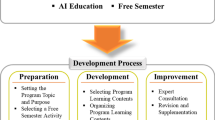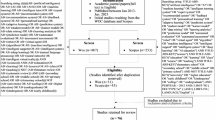Abstract
Robotics technology has gained significance in educational environments in recent years. Educational robotics provide students with the opportunity to collaborate in science, technology, engineering and mathematics (STEM) oriented activities. This study aims to examine the effects of robotics training on children’s spatial ability and attitude toward STEM. A one-group pretest–posttest design, a type of pre-experimental design, was used in the study. The participants were 39 elementary school students (34 boys and 5 girls aged 8–12) who participated in a long-term (31 weeks) robotics course. The course had four main learning objectives related to STEM fields: mechanical design, electronics, algorithms, and robotics programming. The spatial visualization and mental rotation tests were used to determine the children’s spatial ability. The STEM attitude scale was used to reveal their attitudes toward science, technology, engineering, mathematics, and related twenty-first century skills. Data were analyzed using t-test and Wilcoxon signed ranks tests. According to the findings, the children’s spatial visualization and mental rotation test scores were significantly increased at the end of the course. Moreover, the children’s attitudes toward STEM were significantly improved. The results showed that educational robotics may improve children’s spatial ability and attitudes toward STEM. The implications of the study were discussed in detail.



Similar content being viewed by others
References
Alemdar M, Rosen JH (2011) Introducing K-12 teachers to LEGO Mindstorm Robotics through a collaborative online professional development course. In: 2011 ASEE Annual conference and exposition, pp 22–959
Alimisis D (2013) Educational robotics: open questions and new challenges. Themes Sci Technol Educ 6(1):63–71
Andersen L (2014) Visual–spatial ability: important in STEM, ignored in gifted education. Roeper Rev 36(2):114–121
Atmatzidou S, Demetriadis S (2016) Advancing students’ computational thinking skills through educational robotics: a study on age and gender relevant differences. Robot Auton Syst 75:661–670
Avsec S, Kocijancic S (2014) Effectiveness of inquiry-based learning: how do middle school students learn to maximize efficacy of water turbine? Int J Eng Educ 30(6A):1436–1449
Barak M, Assal M (2018) Robotics and STEM learning: Students’ achievements in assignments according to the P3 task taxonomy- practice, problem solving, and projects. Int J Technol Des Educ 28(1):121–144
Barker BS, Ansorge J (2007) Robotics as means to increase achievement scores in an informal learning environment. J Res Technol Educ 39(3):229–243
Benitti FBV (2012) Exploring the educational potential of robotics in schools: a systematic review. Comput Educ 58(3):978–988
Bers MU (2010) The TangibleK Robotics program: applied computational thinking for young children. Early Child Res Pract 12(2):n2
Bruciati AP (2004) Robotics technologies for K-8 educators: a semiotic approach for instructional design. Education Faculty Publications. Paper 56. http://digitalcommons.sacredheart.edu/ced_fac/56. Accessed 20 July 2018
Carnevale AP, Smith N, Melton M (2011) STEM: science technology engineering mathematics. Georgetown University Center on Education and the Workforce, Washington, DC
Catlin D (2012) Maximizing the effectiveness of educational robots through the use of assessment for learning methodologies. In: Proceedings of the 3rd international workshop teaching robotics teaching with robotics, pp 43–51
Cohen J (1988) Statistical power analysis for the behavioral sciences, 2nd edn. Erlbaum, Hillsdale
Coxon SV (2012) The malleability of spatial ability under treatment of a FIRST LEGO League-based robotics simulation. J Educ Gifted 35(3):291–316
Creswell JW (2014) Research design: qualitative, quantitative, and mixed methods approaches, 4th edn. Sage, Thousand Oaks
Eguchi A (2014) Educational robotics for promoting twenty-first century skills. J Autom Mob Robot Intell Syst 8(1):5–11
Eguchi A (2016) RoboCupJunior for promoting STEM education, twenty-first century skills, and technological advancement through robotics competition. Robot Auton Syst 75:692–699
Faber M, Unfried A, Wiebe EN, Corn J, Townsend LW, Collins TL (2013) Student attitudes toward STEM: the development of upper elementary school and middle/high school student surveys. In: 120th ASSE Annual conference and exposition, Atlanta
Freeman A, Adams Becker S, Cummins M, Davis A, Hall Giesinger C (2017) NMC/CoSN horizon report: 2017 K–12 edition. The New Media Consortium, Austin
Friday Institute for Educational Innovation (2012) Middle and high school STEM-student survey. Author, Raleigh
Gerecke U, Wagner B (2007) The challenges and benefits of using robots in higher education. Intell Autom Soft Comput 13(1):29–43. https://doi.org/10.1080/10798587.2007.10642948
González-Calero JA, Cózar R, Villena R, Merino JM (2019) The development of mental rotation abilities through robotics-based instruction: An experience mediated by gender. Br J Educ Technol 50(6):3198–3213
Harden SM, Allen KC, Chau CN, Parks SL, Zanko AL (2012) Experiential learning in graduate education: development, delivery, and analysis of an evidence-based intervention. Creat Educ 3:649–657
Hegarty M, Crookes RD, Dara-Abrams D, Shipley TF (2010) Do all science disciplines rely on spatial abilities? Preliminary evidence from self-report questionnaires. In: International conference on spatial cognition. Springer, Berlin, pp 85–94
Julià C, Antolí JÒ (2016) Spatial ability learning through educational robotics. Int J Technol Des Educ 26(2):185–203
Kandlhofer M, Steinbauer G (2016) Evaluating the impact of educational robotics on pupils’ technical-and social-skills and science related attitudes. Robot Auton Syst 75:679–685
Kell HJ, Lubinski D (2013) Spatial ability: a neglected talent in educational and occupational settings. Roeper Rev 35(4):219–230
Khine MS (2017) Spatial cognition: key to STEM success. In: Khine MS (ed) Visual-spatial ability in STEM education. Springer, Cham, pp 3–8
Kolb AY, Kolb DA (2012) Experiential learning theory. In: Seel N (ed) Encyclopedia of the sciences of learning. Springer, Boston, pp 1215–1219
Kynigos C, Grizioti M, Gkreka C (2018) Studying real-world societal problems in a STEM context through robotics. arXiv preprint arXiv:1806.03245
Leite I, Castellano G, Pereira A, Martinho C, Paiva A (2014) Empathic robots for long-term interaction. Int J Soc Robot 6(3):329–341
Leonard J, Buss A, Gamboa R, Mitchell M, Fashola OS, Hubert T, Almughyirah S (2016) Using robotics and game design to enhance children’s self-efficacy, STEM attitudes, and computational thinking skills. J Sci Educ Technol 25(6):860–876
Lin C, Liu EZ, Kou C, Virnes M, Sutinen E, Cheng S-S (2009) A case analysis of creative spiral instruction model and students’ creative problem solving performance in a Lego® robotics course. In: Chang M, Kuo R, Kinshuk, Chen G-D, Hirose M (eds) Edutainment 2009. LNCS, vol 5670. Springer, Heidelberg, pp 501–505
Lin CH, Liu EZF, Huang YY (2012) Exploring parents’ perceptions toward educational robots: gender and socioeconomic difference. Br J Educ Technol 43(1):E31–E34. https://doi.org/10.1111/j.1467-8535.2011.01258.x
Liu EZ-H, Lin C-H, Feng H-C, Hou H-T (2013) An analysis of teacher–student interaction patterns in a robotics course for kindergarten children: a pilot study. Turk Online J Educ Technol 12(1):9–18
Liu EZF, Lin CH, Chang CS (2010) Student satisfaction and self-efficacy in a cooperative robotics course. Soc Behav Personal 38(8):1135–1146
Lohman DF (1993) Spatial ability and g. Paper presented at the Spearman Seminar, University of Plymouth. https://pdfs.semanticscholar.org/5fa3/456fcf0c3f16b4db2b49e10b3443461f2209.pdf. Accessed 21 July 2018
Mayer RE, Sims VK (1994) For whom is a picture worth a thousand words? Extensions of a dual-coding theory of multimedia learning. J Educ Psychol 86(3):389
Mauch E (2001) Using technological innovation to improve the problem-solving skills of middle school students: educators’ experiences with the LEGO Mindstorms robotic invention system. Clear House 74(4):211–213
Miller B, Kirn A, Anderson M, Major JC, Feil-Seifer D, Jurkiewicz M (2018) Unplugged robotics to increase K-12 students’ engineering interest and attitudes. In: 2018 IEEE frontiers in education conference (FIE). IEEE, pp 1–5
Mitnik R, Nussbaum M, Soto A (2008) An autonomous educational mobile robot mediator. Autonomous Robots 25(4):367–382. https://doi.org/10.1007/s10514-008-9101-z
Modi K, Schoenberg J, Salmond K (2012) Generation STEM: what girls say about science, technology, engineering, and math. A Report from the Girl Scout Research Institute. Girl Scouts of the USA, New York
Nugent G, Barker B, Grandgenett N (2008) The effect of 4-H robotics and geospatial technologies on science, technology, engineering, and mathematics learning and attitudes. In Luca J, Weippl E (eds) Proceedings of world conference on educational multimedia, hypermedia and telecommunications. AACE, Chesapeake, pp 447–452
Nugent G, Barker B, Grandgenett N, Adamchuk V (2009) The use of digital manipulatives in k-12: robotics, GPS/GIS and programming. In: Frontiers in education conference, 2009. FIE ‘09. 39th IEEE, pp. 1–6, 18–21. http://ieeexplore.ieee.org/stamp/stamp.jsp?tp=&arnumber=5350828. Accessed 25 July 2018
Nugent G, Barker B, Grandgenett N, Welch G (2016) Robotics camps, clubs, and competitions: results from a US robotics project. Robot Auton Syst 75:686–691
Papert S (1980) Mindstorms: children, computers and powerful ideas. Basic Books, New York
Papert S (1999) Vision-making, new technologies, and powerful ideas in education. A talk at Heartland Area, p 11
Petre M, Price B (2004) Using robotics to motivate ‘back door’ learning. Educ Inf Technol 9(2):147–158
Peters M, Laeng B, Latham K, Jackson M, Zaiyouna R, Richardson C (1995) A redrawn Vandenberg and Kuse mental rotations test: different versions and factors that affect performance. Brain Cogn 28(1):39–58
Piaget J (1974) To understand is to invent. Basic Books, New York
Rafi A, Anuar K, Samad A, Hayati M, Mahadzir M (2005) Improving spatial ability using a web-based virtual environment (WbVE). Autom Constr 14(6):707–715
Resnick M (2007) Sowing the seeds for a more creative society. Learn Lead Technol 35(4):18–22
Somyürek S (2015) An effective educational tool: construction kits for fun and meaningful learning. Int J Technol Des Educ 25(1):25–41
Sutton K, Williams A (2007) Research outcomes supporting learning in spatial ability. In: Proceedings, Australiasian Association of Engineering Education conference
Uttal DH, Cohen CA (2012) Spatial thinking and STEM education: when, why and how? In: Ross BH (ed) The psychology of learning and motivation. Academic Press, New York, NY, pp 147–181. https://doi.org/10.1016/B978-0-12-394293-7.00004-2
Verner IM (2004) Robot manipulations: a synergy of visualization, computation and action for spatial instruction. Int J Comput Math Learn 9(2):213–234
Webb RM, Lubinski D, Benbow CP (2007) Spatial ability: a neglected dimension in talent searches for intellectually precocious youth. J Educ Psychol 99(2):397–420
Welch AG (2010) Using the TOSRA to assess high school students’ attitudes toward science after competing in the FIRST robotics competition: an exploratory study. Eurasia J Math Sci Technol Educ 6(3):187–197
Williams D, Ma Y, Prejean L, Lai G, Ford M (2007) Acquisition of physics content knowledge and scientific inquiry skills in a robotics summer camp. J Res Technol Educ 40(2):201–216
Winter JW, Lappan G, Fitzgerald W, Shroyer J (1989) Middle grades mathematics project: spatial visualization. Addison-Wesley, NY
Wurdinger SD, Carlson JA (2010) Teaching for experiential learning: five approaches that work. Rowman and Littlefield Education, Lanham
Yildirim B, Selvi M (2015) Adaptation of STEM attitude scale to Turkish. Turk Stud Int Period Lang Lit Hist Turk Turk 10(3):1107–1120
Yıldız B, Tüzün H (2011) Effectsof using three-dimensional virtual environments and concrete manipulatives on spatial ability. J Hacet Univ Educ Fac 41:498–508
Zhong B, Xia L (2018) A systematic review on exploring the potential of educational robotics in mathematics education. Int J Sci Math Educ. https://doi.org/10.1007/s10763-018-09939-y
Acknowledgements
This study was supported by the Scientific Research Project Coordination Unit of Istanbul University. Project number: BEK-2017-24541.
Author information
Authors and Affiliations
Corresponding author
Ethics declarations
Conflict of interest
The authors declare that they have no conflict of interest.
Additional information
Publisher's Note
Springer Nature remains neutral with regard to jurisdictional claims in published maps and institutional affiliations.
Rights and permissions
About this article
Cite this article
Sisman, B., Kucuk, S. & Yaman, Y. The Effects of Robotics Training on Children’s Spatial Ability and Attitude Toward STEM. Int J of Soc Robotics 13, 379–389 (2021). https://doi.org/10.1007/s12369-020-00646-9
Accepted:
Published:
Issue Date:
DOI: https://doi.org/10.1007/s12369-020-00646-9




